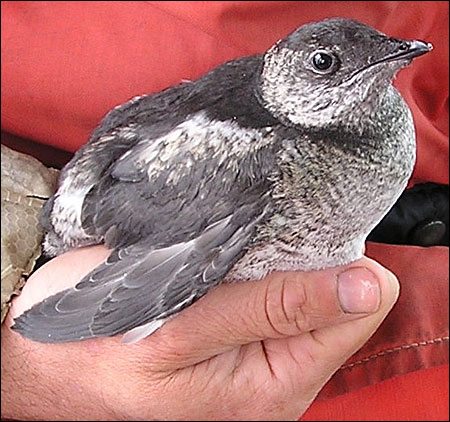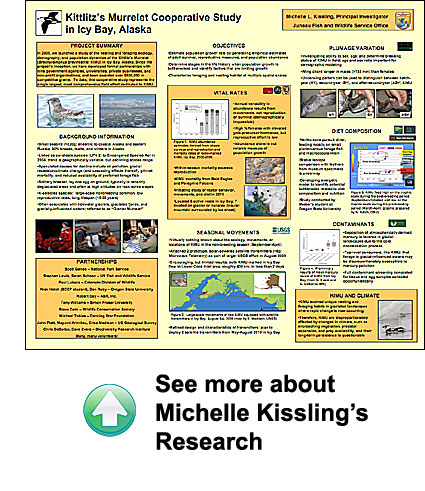Alaska: Important Findings
 Endemic to coastal Alaska and eastern Russia, the Kittlitz’s Murrelet (Brachyramphus brevirostris) is one of the rarest seabirds in the world. The majority (roughly 90%) of the global population breeds, molts, and winters in Alaska. During the breeding season, this species often associates with tidewater glaciers, and glaciated fjords and streams. Kittlitz’s Murrelets have low reproductive rates: they are non-colonial, likely delay breeding until three years of age, and lay a single egg, typically in recently deglaciated areas and often at high altitudes on rock scree slopes. The winter range of the Kittlitz’s Murrelet is not well known, but based on opportunistic sightings, is likely pelagic.
Endemic to coastal Alaska and eastern Russia, the Kittlitz’s Murrelet (Brachyramphus brevirostris) is one of the rarest seabirds in the world. The majority (roughly 90%) of the global population breeds, molts, and winters in Alaska. During the breeding season, this species often associates with tidewater glaciers, and glaciated fjords and streams. Kittlitz’s Murrelets have low reproductive rates: they are non-colonial, likely delay breeding until three years of age, and lay a single egg, typically in recently deglaciated areas and often at high altitudes on rock scree slopes. The winter range of the Kittlitz’s Murrelet is not well known, but based on opportunistic sightings, is likely pelagic.
The current Alaska population is estimated to be approximately 16,000 birds (nearly half occur in southeast Alaska). This represents a dramatic decline over the past 30 years with declines of up to 18% per year in some core areas. Speculated causes for decline include oil pollution, glacial recession (and cascading effects thereof), gill-net mortality, and reduced availability of preferred forage fish. The fate of the Kittlitz’s Murrelet is likely linked to changes in climate; extirpation in some key populations is predicated as early as 2030.
Important Findings
To date, this cooperative study represents the single largest field effort dedicated to the conservation of the Kittlitz’s Murrelet. Monitoring efforts, including development of a long-term monitoring plan, have been conducted since 2002. Despite the pristine conditions and that Icy Bay represents the highest density of Kittlitz’s Murrelets in any area, a decline of 53% over six years was documented. In addition to population monitoring, long-term data have been collected on reproduction and survival. New information on previously unknown aspects of the natural history and ecology of this species, including adult and juvenile dispersal, diet, molting patterns, movements, and nesting and foraging behaviors, have also been collected. Additionally, blood, tissue, and feather samples are currently being tested for As part of these ongoing efforts, 135 adult and three juvenile Kittlitz’s Murrelets have been captured, banded, and measured. Ninety-six radio-transmitters have been deployed and tracked during the breeding and post-breeding seasons.
 Despite high fecundity (90% based on hormone and protein levels), productivity of radio-tagged adults was low (5% attempted to nest; even fewer fledged young successfully). Another surprising result was that adult mortality during the breeding season was relatively high (11%; all resulting from avian predation), suggesting that adult survival may be driving the decline. Data collection, analyses, and reporting are ongoing. Several peer-reviewed publications and annual reports are available.
Despite high fecundity (90% based on hormone and protein levels), productivity of radio-tagged adults was low (5% attempted to nest; even fewer fledged young successfully). Another surprising result was that adult mortality during the breeding season was relatively high (11%; all resulting from avian predation), suggesting that adult survival may be driving the decline. Data collection, analyses, and reporting are ongoing. Several peer-reviewed publications and annual reports are available.
For More Information
Michelle L. Kissling
U.S. Fish and Wildlife Service
3000 Vintage Blvd., Suite 201
Juneau, AK 99801
(907) 780-1160
Visit the Alaska Region website for the
U.S. Fish & Wildlife Service, and learn more.
